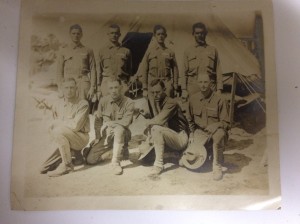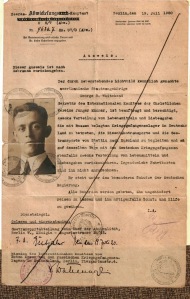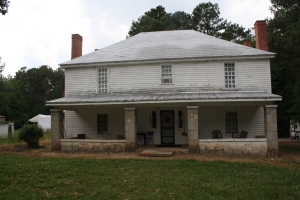My adventurous cousin Charlie went and found us the cemetery to our fourth great grandfather, Littleberry Mathews. I have written about his son on this blog. You can find it HERE. I had previously done research on the Mathews line, but I hadn’t really reviewed the information that I had on Littleberry until Charlie’s field trip. While doing so today, I learned that his given name was “Isaac Littleberry Mathews.” He went by the name Berry or Littleberry. He was the son of William Mathews and Mary Miller. He was born on 27 May 1786. There is some information that indicates he was either born in North Carolina or Georgia.
While researching, I found this descendant chart online that shows the descendants of Gwaethvded Vawr (Lea, 2019). This is unbelievable that someone has traced their lineage back to the year 1025. This descendant chart has some citations to lead to one’s credibility. Today, I just want to focus on my fourth great grandfather.
Berry’s parents had about 8 children. It appears that Berry was the third child to be born to William and Mary Mathews. We will look at the parents at a later time. Berry married Jerusha Hopper on 6 April 1807 in Oglethorpe County, Georgia. He was 20 yeas old.
In his will, I found online, it appears he had more children than I had previously thought. I will have to do some more research. According to his will, he had the following sons: Rolley (Raleigh, my 3rd great-grandfather), Charles, William, Uel, Berry, Pressley, Fleming, Richmond, and Newton. We also learn that his daughter Patsy (Martha Patsy) married Moses Jones, and his daughter Frankey (Francis) married William Jones.

Isaac Littleberry Mathews Will Pt.1

ILM, Will Part 2
It is written that Berry and his wife Jerusha were buried on their home place in Glade. So, the place that cousin Charlie visited was steps away from the homeplace of Berry Mathews family.

Graves at Cemetery

Closeup image
Cousin Charlie sent me a few words on his exploration of the cemetery:

Chimney Ruins

Chimney Ruins 2
At Point Peter, GA a.k.a. the Glade community you take the North Point Peter Road going east between the Baptist Church and the Masonic Lodge. Two roads go east out of the Glade. This would be the southernmost road. Go a little lover 100 yards east and take the first drive to the right. There is a metal gate but almost never closed. Go down the lane about 500 feet and you see an old quarry site that has been converted to a gigantic swimming pool.
The Little Berry Mathews cemetery is about 400 yards SE of the quarry in the woods. There is a clear lane and [the owner] is very receptive to having visitors if you let her know you are coming. The cemetery is on a little hill and just to the west of the cemetery is another little rise where the old Mathews home-place house was. Nothing is left now but the chimney ruins.
The three graves are about 12 feet apart. Each is actually a single crude mausoleum made of very heavy solid granite hand quarried slabs. On two of them the top cover slabs have been moved somewhat leaving an opening and the end stone is out of one of them. They would remind you of a sarcophagus and I cannot overemphasize the mass of the stones. There may have been a possibility that the coffins were above ground but I doubt it. However, the interior of each individual mausoleum is large enough for that to have been possible. For the times this was done and the early construction based on the crudeness of the engraving on the stones, this would have been the top of the line grave marker (Snelling, 2019).
Here is another description by another grave explorer:
The top, sides and ends are thus enclosed and are in very good repair. The tombs read as follows: First tomb: L.B. Mathews Born May 27 1786 Decd. Feb 13, 1845; Second tomb: Richmond Mathews Born Feb 24 1825 Decd. July 29 1846; Third Tomb: Jerusha M. Born May 1, 1790 Decd. Oct 5 1848. A fourth tomb was found but it was not as elaborate as the above ones were as it was only a head stone with the initials J M cut on it. Assume it would belong to the young son Jordan (Lea, 2019).
We can try to trace Isaac Littleberry “Berry” Mathews, Sr through the US Census and other records. The First US Census was mandated by Article 1, Section 2 of the United States Constitution. It was first taken in 1790. However, census records posed difficulties due to lack of concrete information. It would stand to reason that we would look for Berry in his father’s (William Mathews) census records for the year 1790 and 1800. However, I have not yet found any records that are verifiable.
I was able to find a notation that Littleberry Mathews was allowed to sell spirituous liquor on 5 August 1822 in Oglethorpe County. Unfortunately, I found this record before I was skilled in my citation skills.
I catch up to Berry in the 1830 Census. Berry Mathews lived in Captain Pass District, Oglethorpe County, Georgia. Living in the household were 13 “Free White Persons” and 2 “Slaves.” A closer look at the census reveals, nine children and 2 female slaves.
In the 1840 Census, Berry is listed to be living in District 237, Oglethorpe County, Georgia. We can assert that these two locations were likely one in the same, and just the names of the districts changed. He now has 7 “Free White Persons” and “6 Slaves.”
Isaac Littleberry Mathews dies on 13 February 1845, he is just 58 years old. His wife dies just 3 years later. Also buried in the cemetery is Littleberry’s son Richmond.
Until later, I will be exploring backwards.
Source:
Lea, Jenny, found online at Descendants of Gwaethvded Vawr, 2019.
Snelling, Charlie, 2019, email correspondence






















